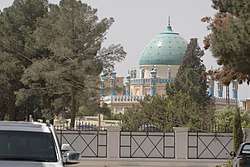Shrine of the Cloak
The Shrine of the Cloak (Pashto: خرقه شريفه Kherqa Sharīfa) is located adjacent to the main mosque in Kandahar, Afghanistan. It contains the Kherqa, a cloak believed to have been worn by the Islamic prophet Muhammad during the famous Night Journey in 621 CE. It is one of the holiest sites in Islam, and even considered by some as the heart of Afghanistan.[1]
| Shrine of the Cloak | |
|---|---|
Kherqa Sharifa | |
 A pilgrim from the United States at the Shrine of the Cloak in 2003 | |
| Religion | |
| Affiliation | Islam |
| Location | |
| Location | Kandahar, Afghanistan |
| Architecture | |
| Type | Mosque |
| Style | Islamic |
The building's exteriors are of green marble from Lashkargah, with tiled surfaces and gilded archways. The cloak itself is locked away inside the mosque and is rarely seen. It has been guarded by the same family for over 250 years.[2] Its guardians have traditionally only shown the cloak to recognized leaders of Afghanistan, although in times of great crisis such as natural disasters, it has been publicly displayed as a means of reassurance.[2] The Tomb of Ahmad Shah Durrani is located adjacent to the Shrine of the Cloak.
History
The cloak was given to Amir Ahmad Shah Durrani (regarded as the founder of modern Afghanistan)[3][4][5][6] by Amir Murad Beg of Bukhara (in modern Uzbekistan) in 1768 in order to solidify a treaty between the two leaders.[7] An alternate account states that when Ahmad Shah had traveled to Bukhara, he saw the cloak of Muhammad. He then decided to take the artifact with him to Kandahar, and asked whether he could "borrow" the cloak from its keepers. They, worrying that he might try to remove it from Bukhara, told him it could not be taken from the city. Ahmad Shah then is said to have pointed to a heavy stela of stone firmly planted in the ground, saying that he would never take the cloak far from the stone. The keepers, gratified at his answer, handed him the cloak. Ahmad Shah then took the cloak, ordered the stone slab to be dug up, and carried them both back with him to Kandahar, where the stone now stands near his mazar (tomb).[1]
In 1996, Mullah Mohammed Omar, the leader of the Taliban, removed the cloak from the shrine and held it in front of a large crowd of his followers.[8][1] This symbolic act is commonly considered a key point in the rise of the Taliban, and in the rise of Omar himself, associating Omar with both Ahmed Shah Durrani and the Islamic prophet Muhammad. Upon Omar's holding of the cloak, the crowd began to shout "Amir al-Mu'minin"[8] (Commander of the Faithful), a title that Ayman al-Zawahiri, the leader of al-Qaeda, occasionally used to refer to Omar.[7] In a New York Times piece from late 2001, the then-keeper of the Shrine, Qari Shawali, confirmed that in 1996, he allowed Omar to view the cloak and remove it from the shrine. Shawali added that only two persons had looked at the cloak in his lifetime before Omar. The first person was Mohammed Zahir Shah, the last King of Afghanistan, who twice opened the chest in which the cloak was kept but proceeded no further. The second person was Pir Ahmed Gailani, a political leader and one of Zahir's relatives.[8] In 2012, Waheed Muzhda, an Afghan political analyst and one-time high-ranking official in the Taliban foreign ministry, corroborated that Omar held the cloak but denied a claim that he donned the cloak: "From what I know, from sources close to Omar, and from a chat with the keeper of the shrine [where the cloak is kept], Omar did not wear the cloak. With great respect, he held the cloak in front of the religious leaders gathered for allegiance."[9]
In June 2018, the cloak was last seen in public when Afghan President Ashraf Ghani opened the box of the cloak, and with attendees prayed for peace during a three-day Eid ceasefire in Afghanistan (from 15 to 17 June 2018).[10]
References
- Steve Inskeep (2002-01-10). "The Cloak of the Prophet". npr.org. Retrieved 2008-06-12.
- Kevin Sieff (2012-12-29). "A fight for Afghanistan's most famous artifact". The Washington Post. Retrieved 2012-12-30.
- "Aḥmad Shah Durrānī". Encyclopædia Britannica Online Version. 2010. Retrieved 2010-08-25.
- "Ahmad Shah and the Durrani Empire". Library of Congress Country Studies on Afghanistan. 1997. Retrieved 2010-09-23.
- Friedrich Engels (1857). "Afghanistan". The New American Cyclopaedia, Vol. I. Archived from the original on 2010-10-18.
- Frank Clements (2003). Conflict in Afghanistan: a historical encyclopedia. ABC-CLIO. p. 81. ISBN 978-1-85109-402-8. Retrieved 2010-09-23.
- Edward Girardet; Jonathan Walter, eds. (1998). Afghanistan. Geneva: CROSSLINES Communications, Ltd. p. 291.
- Norimitsu Onishi (2001-12-19). "A Tale of the Mullah and Muhammad's Amazing Cloak". The New York Times. Retrieved 2020-05-02.
- Mujib Mashal (2012-06-06). "The myth of Mullah Omar". aljazeera.com. Retrieved 2020-05-02.
- Shams Rahmanzai (2018-06-12). "President Ashraf Ghani, opens the sacred cloak related to the Prophet of Islam in the nook of ceasefire". rohi.af. Retrieved 2020-05-02.
External links
- A Pashto language documentary about Kherqa Sharifa (Hewad TV, Jan. 29, 2019).
